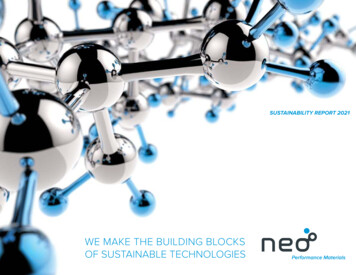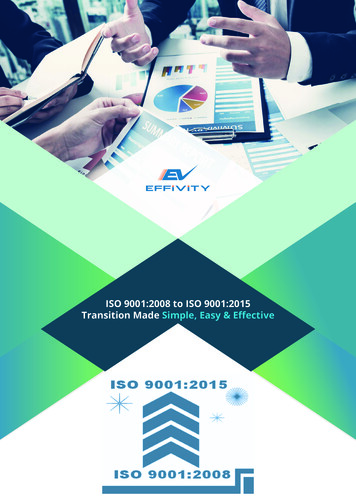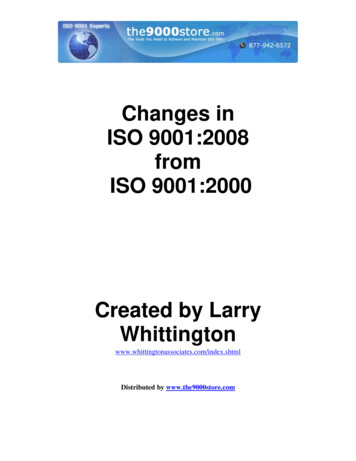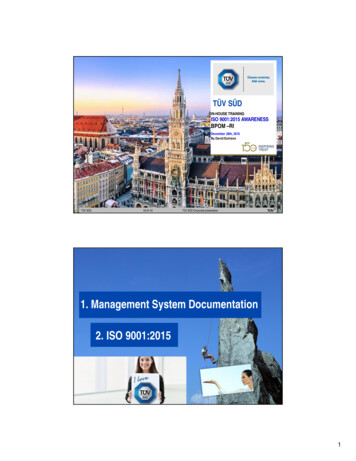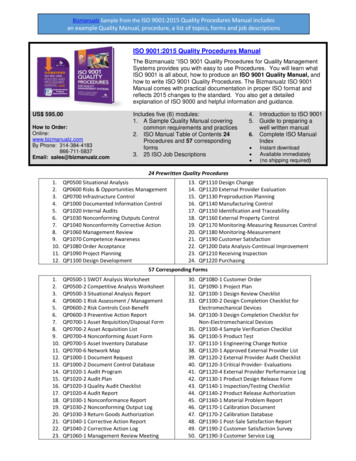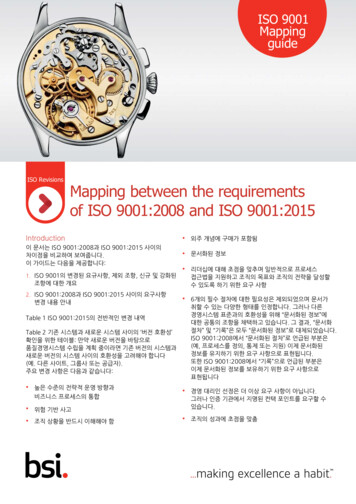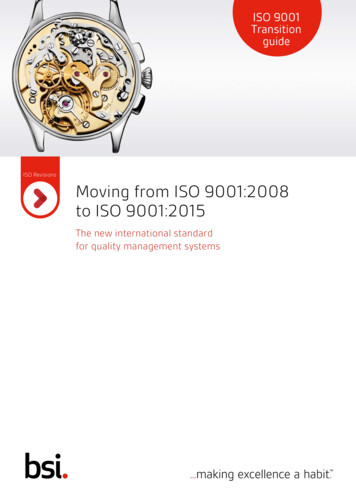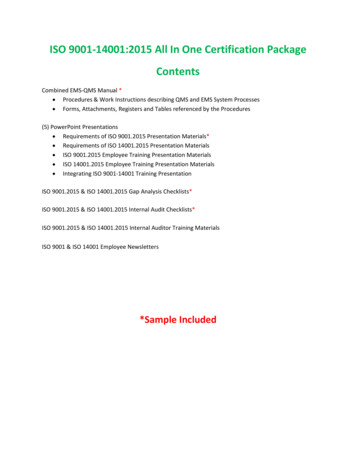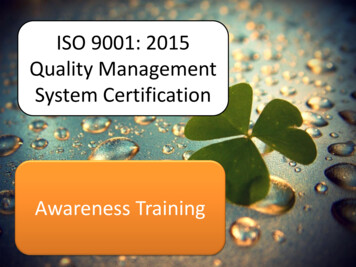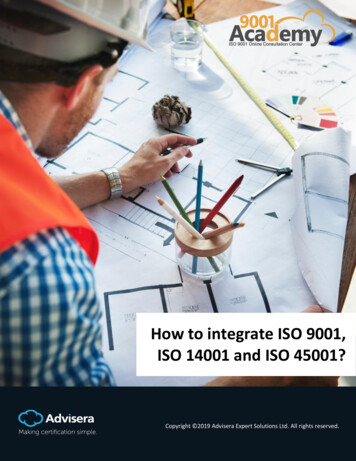
Transcription
How to integrate ISO 9001,ISO 14001 and ISO 45001?Copyright 2019 Advisera Expert Solutions Ltd. All rights reserved.1
Table of ContentsIntroduction .3Why Integrate?.3Where to start? .5Developing a project plan.5Defining the scope of the integrated management system .6Searching for common ground .7Operation .9Common support processes .9Conclusion . 11Sample of documentation templates . 12References. 12About the author. 12Copyright 2019 Advisera Expert Solutions Ltd. All rights reserved.2
IntroductionThere is an ever-increasing competition in the market with a higher awareness of both environmental andhealth & safety performance for companies. This awareness is driving businesses to implement three ofthe ISO standards, ISO 9001 (click here to learn more about ISO 9001), ISO 14001 (click here to learn moreabout ISO 14001) and ISO 45001 (click here to learn more about ISO 45001). Many companies have seenthe benefit of implementing these three standards, as they provide focus on different and importantaspects of the organization; the Quality Management System (QMS) for ISO 9001, the EnvironmentalManagement System (EMS) for ISO 14001 and the Occupational Health & Safety Management System(OHSMS) for ISO 45001. With the release of the new versions of these three standards in the last fewyears, the best option is to integrate the standard requirements and create an Integrated ManagementSystem (IMS). Implementation of the standards at the same time, but separately, can compound thechallenges and even things that seem easy during implementation of one standard can becomeproblematic. Since the complexity of implementation grows with more than one standard, the necessityof the systematic approach was never so crucial.Why Integrate?Having three management systems implemented separately will triple the time and resources needed formaintenance. This includes performing the same activity more than once, such as internal audit ormanagement review, not to mention the proliferation of documentation to support the managementsystems.In some cases, each standard is implemented by a different team or group, so the systems may followdifferent logic or have different structures. Also, the documents and processes that are common for thestandards can be established differently, thus bringing added confusion to an already complex system.Having separate management systems inside of one company can easily be turned into an organizationalnightmare, and instead of benefiting to the business, they become a burden that everyone tries to avoid.On the other hand, having one Integrated Management System that meets the requirements of all thestandards facilities an easier maintenance and coordination of activities. One quick glance at the text ofthe standards shows that there is a great similarity between the requirements, especially now that theyare all aligned with Annex SL (for more information about Annex SL and the Plan-Do-Check-Act cyclerelated to it, see Has the PDCA Cycle been removed from the new ISO standards?). One of the objectivesin the revision of the standards was to facilitate their integration, and that is the reason why the commonrequirements of all the standards have the same clause numbers.For more information, see How to integrate ISO 45001 with ISO 9001 and ISO 14001.Copyright 2019 Advisera Expert Solutions Ltd. All rights reserved.3
Common clauses of ISO 9001:2015, ISO 14001:2015 and ISO 45001:2018As mentioned earlier, the new versions of the standards are following the Annex SL structure and aremore compatible than ever before, because the same requirements are under the same clause numbersin all standards. Here is an overview of the clauses and their similarities. Since the implementationrequirements are located in clauses 4 to 10, we will focus on these:ISO9001Clause NumbersISO 14001NoteISO 450014: Context of theorganization4: Context of theorganization4: Context of theorganization5: Leadership5: Leadership5: Leadership6: Planning6: Planning6: Planning7: Support7: Support7: Support8: Operation8: Operation8: Operation9: Monitoring,measurementand analysis9: Monitoring,measurementand analysis9: Monitoring,measurementand analysis10: Improvement10: Improvement10: ImprovementThe requirements are the same; onlyISO 9001 refers to quality, ISO 14001refers to environment and ISO 45001refers to occupational health & safety.The requirements are the same; onlythe focus of the policies are different.In addition to addressing risks andopportunities, which is required by allstandards, ISO 14001 has additionalrequirements related to environmentalaspects and compliance obligations. ISO45001 also has additional requirementsrelated to OH&S hazards and legalrequirements. The requirements forobjectives are almost the same, only ISO9001 refers to quality, ISO 14001 refersto environment and ISO 45001 refers tooccupational health & safety.The requirements are the same.All standards require the organization toestablish operational controls forprocesses. ISO 9001 discusses theprocesses to provide products andservices, while ISO 14001 and ISO 45001include additional requirements foremergency preparedness and response.The requirements are the same, onlywith different perspectives. ISO 9001has a requirement to monitor andmeasure customer satisfaction, whileISO 14001 and ISO 45001 requireevaluation compliance to obligations.The requirements of all standards arethe same.Copyright 2019 Advisera Expert Solutions Ltd. All rights reserved.4
The benefits of integration include the following: Possibility to preserve resourcesPossibility to decrease the volume of documentationPossibility for better connection between processes and activitiesPossibility to avoid overlapping activities, processes, etc.Where to start?The starting point for the implementation and integration process can be different, depending on thesituation in your company. The company may be implementing the standards for the first time, it mightalready have implemented one of the standards and wants to upgrade the system by implementing more,or the company might have implemented the standards separately and now wants to integrate them intoone IMS. This equation can have additional variables, such as if an older version of a standard isimplemented or a previous management system is in place (such as OHSAS 18001, which is being replacedby ISO 45001), so the project of integration could include transition as well.It is vital to determine the starting point and the current state of the management system, and to definewhat needs to be achieved. When possible, it is best that the standards be implemented simultaneously,following the PDCA cycle that is built into the standards (for more information about PDCA, see Plan-DoCheck-Act in the ISO 9001 standard and Plan-Do-Check-Act in the ISO 14001 standard). A company shouldstart with the requirements for determining context of the organization from all three standards andmove forward to the continual improvement clause.Developing a project planMaking such a complex system should not be done ad-hoc. For a successful implementation and latermaintenance of your IMS, it is crucial to approach it systematically and develop a project plan. This planneeds to include precisely defined activities, resources, responsibilities and deadlines. Doing this enablesthe company to clearly identify what needs to be done, how long it will take, what resources are needed,and who will do it in the best way. A good plan will facilitate the integration and allow some of the tasksto be performed simultaneously, decreasing the time needed for the implementation project.The diagram below shows the timeline and sequence of the activities to be performed and requirementsto be met in order to acquire certification to ISO 9001, ISO 14001 and Iso 45001 together.Copyright 2019 Advisera Expert Solutions Ltd. All rights reserved.5
The best way to start is to perform a gap analysis to determine what requirements of the standards arealready met, and what needs to be done to achieve full compliance. The gap analysis results may showdiscrepancies between standard requirements and organizational practice, and can give a direction forcertain implementation activities.Implementation activities can vary depending on the organizational standardization stage, and couldmean that: It is only necessary to implement the requirements of the new versions of the standards.It is possible to integrate the common requirements of the standards that are alreadyimplemented.It is necessary to implement new standard(s).It is necessary to conduct a transition of the already implemented standard.It is necessary to implement all standards at once from the beginning.Whatever the case, the integration is a good opportunity to revise existing systems and introduce theimprovements.For more information, see: Four things you need to start your ISO 9001 project, 5 elements of a successfulISO 14001 project and 5 tips to make your ISO 45001 implementation project successful.Defining the scope of the integratedmanagement systemTo set a firm foundation for the system, the company must first determine the scope of the managementsystem by defining what locations and processes the system applies to. Having separate systems for ISO9001, ISO 14001 and ISO 45001 allows having separate scopes, which can be convenient in some casesbut, for most companies, the scope will be the same. The scope is usually the entire company, or it couldbe only some of the processes and locations. For more information, see: How to define the scope of theQMS according to ISO 9001:2015, How to determine the scope of the EMS according to ISO 14001:2015and How to determine scope of the OH&SMS.All standards require the scope to be documented (see here for a free preview of Scope of the IntegratedManagement System); the only difference is that ISO 9001 allows organizations to determine whatrequirements of the standard are not applicable to the organization, and can therefore be excluded fromCopyright 2019 Advisera Expert Solutions Ltd. All rights reserved.6
the scope of the IMS. This is only applicable if the exclusion does not affect the company’s ability to ensureconformity of products and services, or the enhancement of customer satisfaction, and justification mustbe given for any exclusions. For more information, see: What clauses can be excluded in ISO 9001:2015?Searching for common groundThe next step is to identify all of the common requirements from the three standards, and this is not ashort list. Basically, clauses 4, 5, 7, 9 and 10 are almost the same, with some small differences. There arequite a lot of common requirements that, with minor adaptations, can be met through a single processor document.The next sections will explain how the standard requirements should be met, the similarities anddifferences between standards, and the sequence for implementing the requirements.PoliciesThe requirements of the quality, environmental and health & safety policies can be met either bycombining them into one integrated policy, or by having separate policies. The important thing is thatthey are compliant with the requirements of the standards, appropriate to the purpose and context ofthe organization, aligned with the strategic direction, provide a framework for setting objectives andinclude a commitment to continual improvement. The differences are that the quality policy includes acommitment to satisfy product and service requirements, the environmental policy includes commitmentto protect the environment and fulfill compliance obligations, and the occupational health & safety policyincludes a commitment to eliminate hazards and reduce risks, to prevent workplace injury, and to consultwith workers. The requirements for communicating the objectives is the same in all standards.For more information on this topic, please see the articles How to write a good quality policy, How towrite an ISO 14001 environmental policy and How to write a good OH&S Policy.Objectives for improvementThe requirements for the quality, environmental and occupational health & safety objectives are prettymuch the same; they need to be consistent with the organization’s policy, measurable, monitored,communicated effectively, and updated when needed. Again, the company may use a single documentto record the objectives, or make separate documents. Having them in one place will enable the companyto monitor them as part of one process and review them easily as part of management review. It will alsobe much easier to manage the resources needed for planning actions if all the information is in one place.For more information on this topic, see the articles How to Write Good Quality Objectives, How to UseGood Environmental Objectives and How to define ISO 45001 objectives and plans.Context of the organizationThis is a new clause that is found in all ISO management system standards, and it requires the organizationto determine all internal and external issues that may be relevant to the purpose and strategic directionCopyright 2019 Advisera Expert Solutions Ltd. All rights reserved.7
of the company. These issues must be applicable to quality, environmental and health & safety elementswhich are, and may be capable of, affecting these objectives and outcomes in the future. If one standardis already implemented, the scope of this process needs to be expanded to cover all standards. Althougha documented procedure is not required to address this clause, it might be a good idea to have one if thisprocess is new for your company. Here you can find a free preview of our Procedure for determiningcontext of the organization and interested parties. For more information on this topic, see these articlesHow to identify the context of the organization in ISO 9001:2015, Determining the context of theorganization in ISO 14001 and Defining the context of the organization according to ISO 45001.Understanding the needs and expectations of interested partiesThe standard now requires the company to assess who the interested parties are within the context ofthe organization. Interested parties are those relevant to the quality of products and services, andcustomer satisfaction, environmental protection and compliance obligations. They also includeoccupational health & safety performance and compliance obligations. The process must include theneeds and expectations that may be related to the IMS and, consequently, if any of these should becomecompliance obligations. For more information on this topic, see the articles How to determine interestedparties and their requirements according to ISO 9001:2015, How to determine interested partiesaccording to ISO 14001:2015 and Determining interested parties according to ISO 45001.Leadership and commitmentTop management needs to demonstrate leadership and commitment by taking accountability for theeffectiveness of the management system, establishing the policies, setting objectives, and complying withother requirements prescribed in clause 5.1 of the standards. Without top management commitment,the management systems will not work properly. For more information, see the articles How to complywith new leadership requirements in ISO 9001:2015 and How to demonstrate leadership according to ISO14001:2015.Risks and opportunitiesThis requirement is new for all the standards and the purpose is the same: to enhance a proactiveapproach to the management system. None of the standards require a formal methodology or adocumented procedure for addressing this requirement. The purpose is to mitigate risks that affect theorganization’s ability to meet its objectives, and to seize the opportunities for improvement. The onlydifference is the focus of the standards. Although a documented procedure is not required, it might beuseful to document all the elements that need to be considered (here you can find a free preview of aProcedure for addressing risks and opportunities). For additional information on this topic, click on thearticles Risk-based thinking replacing preventive action in ISO 9001:2015 – The benefits, RiskManagement in ISO 14001:2015 – What, why and how? and What are the new requirements for risksand opportunities according to ISO 45001?Environmental aspects and OH&S hazardsThere is an obligation in ISO 14001:2015 to identify the methodology for the evaluation of environmentalaspects, and the criteria for determining their significance in the EMS. This obligation is very similar to theone in ISO 45001:2018 to identify the occupational health & safety risks present in your company, andeach can use a similar methodology. These obligations are both related to clause 4.4 in ISO 9001 whichemphasizes the necessity to define the business activities, including interactions. For more informationCopyright 2019 Advisera Expert Solutions Ltd. All rights reserved.8
on this topic, see the articles 4 steps in identification and evaluation of environmental aspects and Howto identify and classify OH&S hazards.Compliance obligationsThis is a relatively straightforward, but obviously vital part of both ISO 14001:2015 and ISO 45001:2018.The company must decide what legal and other requirements are related to its environmental protectionand occupational health & safety hazards and how to best assess them and decide how they apply to theorganization. This can easily be merged into the process for identification and evaluation of interestedparties and their needs and expectations, since documented evidence needs to be recorded for theseobligations. For more information on this topic, see the articles Compliance requirements according toISO 14001:2015 – What has changed? and How to identify and comply with legal requirements in ISO45001.OperationThis is the core of the standard, the “Do” phase of the Plan-Do-Check-Act cycle, and this is whereintegration can pay benefits. If the company has integrated the ISO 9001, ISO 14001 and ISO 45001standard, operational planning and control will not be conducted separately and will not triple the use ofresources in some phases. It might seem easier to have separate operational information, however if youkeep these process instructions separate, then the people who need to perform the processes will needto look for the information in different places to do their job. This is why it is important to include therequirements of all standards when developing a procedure for a single process. When defining theprocess required to provide products and services, establishing criteria and resources, it is vital that youalso include the operational controls for the environment and health & safety. By doing this, you cancreate one workflow for the process that includes everything employees need to know.For more information, see this article Understanding relationship between environmental aspects andoperational procedures.Common support processesDocumented information - The requirements on documented information are the same for all standards,identifying how to create, update and control the documents and records you need. This means thatintegrating these systems will ensure that the process of document and record control will be easy, andyou will facilitate control of all documents and records throughout the company. For more informationon this topic, please see the articles New approach to document and record control in ISO 9001:2015, ACopyright 2019 Advisera Expert Solutions Ltd. All rights reserved.9
new approach to documented information in ISO 14001:2015 and A new approach to ISO 45001documentation.Managing Resources – This can be done simultaneously and will be compliant with the requirements ofall standards. Simply put, the standards advise that the organization needs the resources required toachieve the stated objectives. ISO 9001 additionally separates these resources into several sub-clauses:people, infrastructure, environment for operation of processes, monitoring and measurement resourcesand organizational knowledge.Competence & Awareness - Awareness is closely related to competence in the standard, and therequirements can be met through the same process for quality, environment, and health & safety. Thiscan even facilitate the process since all the training and awareness-raising sessions will be bettercoordinated. For more information, see the articles How to ensure competence and awareness in ISO9001:2015 and ISO 14001 Competence, Training & Awareness: Why are they important for your EMS?Communication - All of the standards have the same core requirements, you need to determine thedetails of communication such as who, what, when, and how. ISO 14001 and ISO 45001 additionallyexpand the requirements by dividing them into internal and external communication, emphasizingcompliance obligations and consistency of information. The same communication process can be used tomeet the requirements of all the standards.Emergency preparedness and responseWhile not a requirement of ISO 9001, both ISO 14001 and ISO 45001 have emergency preparedness andresponse as a key element in the mitigation of risk. It is the responsibility of the company to be preparedshould a predictable problem happen, and a number of elements should be considered and planned forto mitigate incidents. Regular emergency response testing and relevant training need to be consideredand undertaken. For more information on this topic, see the articles ISO 14001 emergency preparednessand response and How to be prepared for a health and safety incident.Monitoring, measuring, analysis, and evaluationAll of the standards require that the company define what will be monitored and measured, how it willbe done, how often it needs to be done, and how the results will be analyzed. Besides the differentperspectives of the standards, the difference is that ISO 9001 has a separate sub-clause with requirementsregarding monitoring and measuring customer satisfaction, while ISO 14001 and ISO 45001 haveadditional requirements for the evaluation of compliance. For more information on this topic, see thearticles Analysis of measuring and monitoring requirements in ISO 9001:2015, ISO 14001 Monitoring &measurement equipment control and What is the purpose and structure of the Health & Safety hazardevaluation record?Internal AuditHow the internal audit is conducted is common to all standards. While you may choose to audit therequirements separately, having one internal audit program will help the organization to bettercoordinate audits and avoid overlapping of resources. In fact, you can find benefits by auditing all aspectsof a process during one audit. For more information on this topic, see the articles Five Main Steps in ISO9001 Internal Audit, Using internal audits to drive real improvement in ISO 14001:2015 and How toperform internal audits in ISO 45001.Copyright 2019 Advisera Expert Solutions Ltd. All rights reserved.10
ImprovementHaving one process to identify nonconformances and manage corrective actions is another easy win forthe integrated management system. Regardless of the origin of the process nonconformity, or which partof the system it comes from, nonconformities can be resolved in the same way. This fact should be usedto develop a single process for managing nonconformities, incidents and corrective actions. For moreinformation on this topic, see the articles ISO 9001 – Difference between correction and corrective action,Environmental Nonconformity Management: How is ISO 14001 different from ISO 9001 and Usingcorrective actions to eliminate nonconformities and drive health & safety improvements.Management ReviewTop management is always happy to save their time on a process, and having one management reviewprocess to discuss the topics related to all standards can do just that – save time. With all of theinformation from all management system standards together in one place, it can become much easier tomake decisions, since the information will provide a wider perspective on the whole system, the resourcesneeded, and the overall performance. It should be noted that the management review does not have tobe done all at once; it can be a series of high-level meetings with topics tackled individually. For moreinformation on this topic, see the articles How to Make Management Review More Practical, Theimportance of management review in the ISO 14001:2015 process and How to perform the initialmanagement review in ISO 45001.ConclusionHaving one integrated management system instead of three separate systems makes the initialimplementation harder but, in the end, the effort invested in the project will be fruitful, as the IMS willbe easier to manage in the long run. Among others, the greatest benefits of having an integratedmanagement system are: Decreased volume of documentationBetter coordination of activities and resourcesBetter understanding of all aspects of a process for employeesIntegrated workflow of activities without overlapping and doubling tasksSystematized information for more effective management reviewThe key point of a successful integration project, or any implementation project, is a good understandingof the requirements and how they can be fulfilled with small engagement of resources to achieve thegreatest effect. To learn more about the ISO 9001, ISO 14001 and ISO 45001 standards see thesewhitepapers Clause-by-clause explanation of ISO 9001:2015, Clause-by-clause explanation of ISO14001:2015 and Clause-by-clause explanation of ISO 45001:2018.Copyright 2019 Advisera Expert Solutions Ltd. All rights reserved.11
Sample of documentation templatesDownload this free preview of the ISO 9001/ISO 14001/ISO 45001 Integrated Documentation Toolkit. Itwill allow you to see samples of policies and procedures used in the implementation of an integratedmanagement system based on ISO 9001:2015, ISO 14001:2015 and ISO 45001:2018.References 9001 AcademyISO 9001 Quality management14001 AcademyISO 14001 Environmental management45001 AcademyISO 45001 Occupational health and safetyAbout the authorMark Hammar is a Certified Manager of Quality / Organizational Excellence through the American Societyfor Quality, and has been a Quality Professional since 1994. Mark has experience in auditing, improvingprocesses and writing procedures for Quality, Environmental and Occupational Health & SafetyManagement Systems, and is certified as a Lead Auditor for ISO 9001, AS9100, and ISO 14001.Copyright 2019 Advisera Expert Solutions Ltd. All rights reserved.12
Advisera Expert Solutions Ltdfor electronic business and business consultingZavizanska 12, 10000 ZagrebCroatia, European UnionEmail: support@advisera.comU.S. (international): 1 (646) 759 9933United Kingdom (international): 44 1502 449001Toll-Free (U.S. and Canada): 1-888-553-2256Toll-Free (United Kingdom): 0800 808 5485Australia: 61 3 4000 0020Copyright 2019 Advisera Expert Solutions Ltd. All rights reserved.13
Common clauses of ISO 9001:2015, ISO 14001:2015 and ISO 45001:2018 As mentioned earlier, the new versions of the standards are following the Annex SL structure and are more compatible than ever before, because the same requirements are under the same clause numbers in all standards. Here is an overview of the clauses and their similarities.

